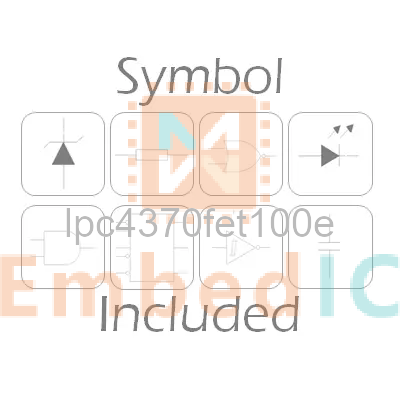IC MCU 32BIT ROMLESS 100TFBGA
 PCB Symbol, Footprint
PCB Symbol, Footprint
 Send Inquiry
Send Inquiry
 Download Datasheet
Download Datasheet
 SUPPLIERS WHOLESALE PRICE TRENDS
SUPPLIERS WHOLESALE PRICE TRENDSPrice comparison from authorized distributors
 LPC4370FET100E Competitive Prices
LPC4370FET100E Competitive Prices
EmbedIC has the unique source of supply. We can offer LPC4370FET100E more competitive price for our customers. You can enjoy our best service by purchasing NXP LPC4370FET100E, Please feel free to contact for the best price of LPC4370FET100E 32bit MCU. Click To Get Quotation
The LPC4370 are Arm Cortex-M4 based microcontrollers for embedded applicationswhich include an Arm Cortex-M0 coprocessor and an Arm Cortex-M0 subsystem formanaging peripherals, 282 kB of SRAM, advanced configurable peripherals such as theState Configurable Timer (SCT) and the Serial General Purpose I/O (SGPIO) interface,two High-speed USB controllers, Ethernet, LCD, an external memory controller, andmultiple digital and analog peripherals including a high-speed 12-bit ADC. The LPC4370operate at CPU frequencies of up to 204 MHz.
The Arm Cortex-M4 is a next generation 32-bit core that offers system enhancementssuch as low power consumption, enhanced debug features, and a high level of supportblock integration. The Arm Cortex-M4 CPU incorporates a 3-stage pipeline, uses aHarvard architecture with separate local instruction and data buses as well as a third busfor peripherals, and includes an internal prefetch unit that supports speculative branching.The Arm Cortex-M4 supports single-cycle digital signal processing and SIMDinstructions. A hardware floating-point processor is integrated in the core.
The LPC4370 include an application Arm Cortex-M0 coprocessor and a second Arm Cortex-M0 subsystem for managing the SGPIO and SPI peripherals. The Arm Cortex-M0 core is an energy-efficient and easy-to-use 32-bit core which is code- and tool-compatiblewith the Cortex-M4 core. Both Cortex-M0 cores offer up to 204 MHz performance with asimple instruction set and reduced code size.
Symbol

Footprint

Core Processor ARM Cortex M4/M0/M0
Speed 204MHz
Operating Temperature -40℃ ~ 85℃ (TA)
Program Memory Type ROMless
RAM Size 282K x 8
Number of I/O 49
Peripherals Brown-out Detect/Reset, DMA, I2S, LCD, POR, PWM, WDT
Mounting Type Surface Mount
Oscillator Type Internal
Supplier Device Package 100-TFBGA (9x9)
Package / Case 100-TFBGA
Core Size 32-Bit Tri-Core
Connectivity CANbus, EBI/EMI, Ethernet, I2C, IrDA, SD, SPI, SSC, UART/USART, USB
Data Converters A/D 3x12b; D/A 1x10b
Voltage - Supply (Vcc/Vdd) 2.2V ~ 3.6V
Manufacturer: Texas Instruments
IC MCU 32BIT 256KB FLASH 64LQFP
Product Categories: 32bit MCU
Lifecycle:
RoHS:
Manufacturer: Microchip
IC MCU 16BIT 144KB FLASH 64TQFP
Product Categories: 16bit MCU
Lifecycle:
RoHS:
Manufacturer: NXP
IC MCU 8BIT 12KB FLASH 64QFP
Product Categories: 8bit MCU
Lifecycle:
RoHS:
Manufacturer: Intel
IC SOC CORTEX-A9 700MHZ 672UBGA
Product Categories: SOC
Lifecycle:
RoHS:
Manufacturer: Intel
IC SOC CORTEX-A9 600MHZ 672UBGA
Product Categories: SOC
Lifecycle:
RoHS:
Manufacturer: Digi International
IC MPU 32B 33MHZ LINUX 208QFP
Product Categories: MPU
Lifecycle:
RoHS:
Manufacturer: Infineon
IC MCU 32BIT 832KB FLASH 144LQFP
Product Categories: 32bit MCU
Lifecycle:
RoHS:
Manufacturer: Microchip
IC MCU 32BIT 64KB FLASH 32VQFN
Product Categories: 32bit MCU
Lifecycle:
RoHS:
Manufacturer: Microchip
IC MCU 16BIT 256KB FLASH 144LQFP
Product Categories: 16bit MCU
Lifecycle:
RoHS:
Manufacturer: Cypress
IC MCU 16BIT 64KB MROM 48LQFP
Product Categories: 16bit MCU
Lifecycle:
RoHS:
Looking forward to your comment
Comment
 Popular Searches
Popular Searches8 Bit MCU, Flash, PIC16 Family PIC16F7XX Series Microcontrollers, 20 MHz, 7 KB, ...
EEPROM 2K 256 X 8 2.5V SERIAL EE IND
System-On-Modules - SOM RCM2200
32-bit Arm Cortex-A53 vision processor with ISP, powerful 3D GPU, dual APEX-2 v...
IC MCU 8BIT 60KB FLASH 44QFP
DSP 20MHZ 44QFP
1
2
3
4
5
6